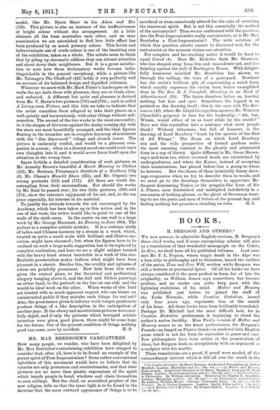MR. MAX BEERBOHM'S CARICATURES.
How many people, we wonder, who have been delighted by Mr. Max Beerbohm's entertaining exhibition have stopped to consider that, after all, here is to be found an example of the purest spirit of Post-Impressionism P Some rather conventional upholders of this movement would have us believe that its votaries are only protesters and revolutionaries, and that their pictures are no more than plastic expressions of the spirit which impels people to break windows and chain themselves to area railings. But the chief, an accredited prophet of the new religion, tells us that the inner light is to be found in the doctrine that the mere outward- appearance of things is to be sacrificed or even consciously altered for the sake of revealing the innermost spirit. But is not this essentially the method of the caricaturist? Thus we are confronted with the question, Are the Post-Impressionists really caricaturists, or is Mr. Max Beerbohm a Post-Impressionist ? The wide solution of which this question admits cannot be discussed now, for the caricaturist at the moment claims our attention.
For complete and far-reaching satire it would be hard to equal Found (4). Here Mr. Ricketts finds Mr. Shannon, who has strayed away from him and unacademic art, and lies fainting against the wall of Burlington House. With delight- fully humorous mischief Mr. Beerbohm has shown us through the railings the vista of a graveyard. Nowhere has the artist's brilliant gift of constructing a weird form which exactly expresses his victim been better exemplified than in The Rev. R. T. Campbell, Standing in no Need of Advertisement (24). The figure dissolves before us, leaving nothing but hair and eyes. Sometimes the legend is as pointed as the drawing itself ; this is the case with The Suc- cession (43), where Mr. Lloyd George thus answers Mr. Winston Churchill's proposal to toss for the leadership —" Ab, but, Winsie, would either of us as loser abide by the result ? " Does not this crystallise into a sentence what most people think ? Without bitterness, but full of humour, is the drawing of Lord Rosebery " beset by the spectre of the End of All Things." The divan on which Lord Rosebery sits and the wide perspective of formal gardens make the most amusing contrast to the ghostly and attenuated form in a cap of liberty. Quite different is Mr. Oscar Brown- ing's mid-term tea, where crowned heads are entertained by undergraduates, and where the Kaiser, instead of accepting their ministrations, has placed before him a group to whom he lectures. But the charm of these inimitably funny draw- ings evaporates when we try to describe them in words, and we must go to the drawings themselves to appreciate Mr. Sargent dominating Venice, or the penguin-like form of Sir Pinero, seen diminished and multiplied indefinitely in a succession of looking-glasses, or the ghost of Stevenson want- ing to see the poets and men of letters of the present day, and finding nothing but preachers standing on tubs. H. S.










































 Previous page
Previous page